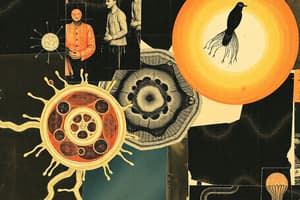Podcast
Questions and Answers
What is the primary function of mitochondria in a cell?
What is the primary function of mitochondria in a cell?
- To store genetic information
- To regulate cell growth
- To synthesize proteins
- To generate energy for the cell (correct)
What is the characteristic of the outer membrane of mitochondria?
What is the characteristic of the outer membrane of mitochondria?
- It is impermeable
- It is the site of energy production
- It is permeable (correct)
- It is folded into cristae
What is the process by which mitochondria produce energy for the cell?
What is the process by which mitochondria produce energy for the cell?
- Cellular respiration (correct)
- Protein synthesis
- Photosynthesis
- Gene expression
What is the term for the DNA found in mitochondria?
What is the term for the DNA found in mitochondria?
How is mitochondrial DNA inherited?
How is mitochondrial DNA inherited?
What stage of cellular respiration occurs in the mitochondrial matrix?
What stage of cellular respiration occurs in the mitochondrial matrix?
Flashcards are hidden until you start studying
Study Notes
Structure and Function
- Mitochondria are organelles found in the cells of most eukaryotes, including animals, plants, and fungi.
- They are often referred to as the "powerhouses" of the cell because they generate most of the energy that the cell needs to function.
Mitochondrial Structure
- Mitochondria have two main parts: the outer membrane and the inner membrane.
- The outer membrane is permeable and allows certain substances to pass through.
- The inner membrane is impermeable and folded into a series of cristae, which increase the surface area for energy production.
- The space between the outer and inner membranes is called the intermembrane space.
- The space inside the inner membrane is called the mitochondrial matrix.
Energy Production
- Mitochondria produce energy for the cell through cellular respiration.
- Cellular respiration involves the breakdown of glucose and other organic molecules to produce ATP (adenosine triphosphate).
- There are three main stages of cellular respiration: glycolysis, the citric acid cycle, and oxidative phosphorylation.
- Mitochondria are the site of the citric acid cycle and oxidative phosphorylation.
Inheritance and Dynamics
- Mitochondria have their own DNA, known as mtDNA, which is separate from the DNA found in the cell's nucleus.
- Mitochondrial DNA is inherited solely through the maternal line, as only egg cells contribute mitochondria to the fertilized egg.
- Mitochondria can divide and fuse with each other, allowing them to share their contents and maintain a healthy population within the cell.
Importance and Dysfunctions
- Mitochondrial dysfunction has been implicated in a wide range of diseases, including neurodegenerative disorders, metabolic disorders, and cancer.
- Mitochondrial diseases can result from mutations in either mtDNA or nuclear DNA.
- Mitochondrial function declines with age, which may contribute to the aging process.
Studying That Suits You
Use AI to generate personalized quizzes and flashcards to suit your learning preferences.



